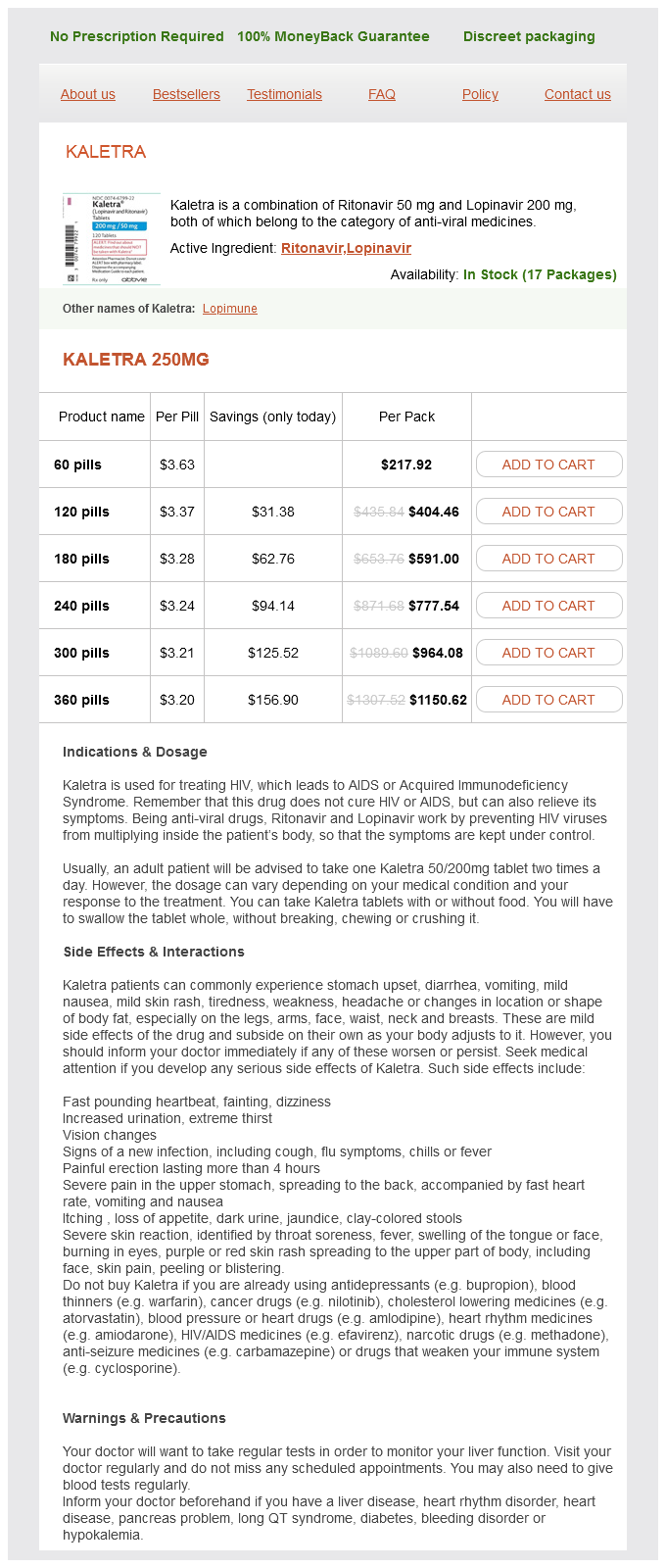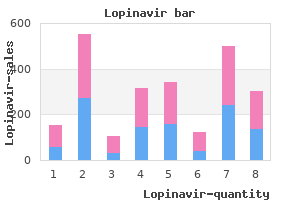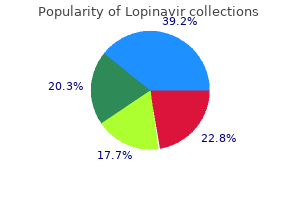Lopinavir

"Generic 250mg lopinavir visa, medicine numbers".
T. Hamid, M.A., M.D., Ph.D.
Deputy Director, University of Nevada, Reno School of Medicine
Deuterated cocaine levels in sweat as high as 50 ug/mL were found one hour after intranasal administration of cocaine at 0 symptoms xanax abuse safe 250mg lopinavir. Two hours after subjects were administered deuterated cocaine they held drug-free hair in their hands for 30 min symptoms quitting weed generic 250 mg lopinavir with amex. The authors concluded that sweat may be an important vehicle for the transfer of cocaine into hair medications 44334 white oblong purchase 250mg lopinavir with amex. In another study medications you cant take with grapefruit buy lopinavir 250mg low price, Henderson142 reported cocaine concentrations greater than 100 ng/mL in sweat for up to 72 h after a single 2 mg/kg intranasal dose. The immunoassay had equivalent cross-reactivity for cocaine, the primary analyte found in sweat after cocaine exposure, and benzoylecgonine, the primary cocaine analyte found in urine. The authors concluded that sweat may be a significant route of elimination for basic drugs and that detecting drug use with the sweat patch is both sensitive and specific. Furthermore, the detection of drug in sweat requires an analytical system designed to detect drug analytes identified in sweat which in many cases are different than the primary drug analytes observed in urine. Following administration of single doses of heroin and cocaine to humans, Cone et al. Sweat was collected by means of a sweat patch that could be worn for up to 7 days. Cocaine appeared in sweat within 1 to 2 h and peaked within 24 h in an apparent dose-dependent manner. Trace amounts of cocaine could be detected in the sweat patch following intravenous dosing of as little as 1 mg. Smaller amounts of ecgonine methyl ester and benzoylecgonine could also be identified, although only following larger doses. Henderson and Wilson138 noted that sweat was a significant route of elimination for methadone. Normal sweat excretion is approximately 500 mL/day, but it is possible to increase sweat excretion up to 1000 mL/h during periods of strenuous exercise or when environmental temperatures approach 100°C. Excessive sweating during strenuous exercise could remove significant amounts of drug from the body and cause a decreased half-life of methadone. Such an occurrence might account for the observance of opiate withdrawal symptoms in some methadone maintenance patients. In 1979, Ishiyama reported that methamphetamine was excreted in sweat at a constant rate of 1. He predicted that the toxicological examination of sweat could offer a new scope to forensic investigations. Ishiyama et al129 detected amphetamine, dimethylamphetamine, and morphine in sweat after exposure to low drug doses. Methamphetamine was detected in sweat for 140 h and in urine for 96 h after a volunteer ingested 10 mg of the drug. Takahashi131 reported the detection of methamphetamine and amphetamine for 4 and 5 days, respectively, in sweat collected after subcutaneous administration of 5 mg/kg methamphetamine to a monkey. It is interesting to note that after repeated injections of methamphetamine, the amphetamine concentration exceeded that of the parent drug due to differences in excretion kinetics between the parent drug and drug metabolite. Drug excretion curves in sweat were found to follow the same pattern as observed in urine. It was suggested that sweat could provide an alternative biological matrix for doping control. Detection of ethanol, phenobarbital, and phencyclidine in sweat has been reported. The time course of excretion of alcohol in the skin vapor was compared to that of ethanol in the blood and the breath. During absorption, alcohol excretion was lower than blood and breath; however, a slightly higher concentration was noted at later time points. The authors reported that although ethanol elimination via sweat did not parallel breath or blood alcohol excretion, analysis of sweat for alcohol could serve as an adequate monitoring device for ethanol ingestion. Smith and Pomposini132 employed radioimmunoassay in a forensic case to detect phenobarbital in perspiration stains. Radiolabeled phencyclidine was detected in axilla perspiration for 54 h after intravenous phencyclidine administration.
Diseases
- Abasia
- Optic disc drusen
- Congenital myopathy
- Chromosome 21 monosomy
- Arc syndrome
- 4-hydroxyphenylacetic aciduria, rare (NIH), Optic atrophy, [1]
- Capillary leak syndrome with monoclonal gammopathy
- Fan death
- Heart aneurysm

Although home-made canned foods remain the major sources of botulism outbreaks medications for ibs purchase lopinavir 250 mg otc, of late there has been an increase in commercially prepared products causing botulism outbreaks symptoms of colon cancer lopinavir 250 mg without a prescription. The case fatality ratio for type A is about 12% symptoms appendicitis order 250 mg lopinavir visa, while for types B and E medications with codeine buy lopinavir 250 mg low cost, it is approximately 10%. A few cases have recently been reported to have been caused by other Clostridium species-Cl. Although most cases of botulism recover completely, especially when prompt treatment is administered, a few may be associated with long-term sequelae such as dysgeusia, dry mouth, constipation, dyspepsia, arthralgia, exertional dyspnoea, and easy fatiguability. Risk factors for this type include recent antibiotic therapy, gastric achlorhydria, and previous intestinal surgery. Botulinum toxin is today finding an important place in therapeutics, being used for the treatment of a number of neurological and ophthalmological disorders. Some of the side effects reported with its use have included the following: headache, ptosis, dysphagia, upper respiratory tract infection, flu-like syndrome, and nausea. The toxin can be easily delivered by aerosol, or used to contaminate food or water supplies. If inhaled, the toxin produces clinical symptoms that are similar to foodborne intoxication; however, time to onset may be delayed. The toxin is relatively easy to produce, and is highly lethal in small quantities. Iraq during the Persian Gulf War and the Aum Shrinrikyo in Tokyo) have been known to produce botulinum toxin as part of their offensive weapons programme. Parvovirus gastroenteritis is the adult variety with an incubation period of 24 to 36 hours, followed by abrupt onset of diarrhoea, vomiting, and abdominal cramps. Viral diarrhoeas are invariably self-limiting and require only rehydration by way of treatment. While many of these agents are more appropriately discussed in textbooks of microbiology or clinical medicine, a few merit special mention here. Chapter 33 Food Poisoning Entamoeba histolytica Source Contaminated food and water. Viruses Common viruses responsible for causing gastroenteritis include astrovirus, calcivirus, enteric adenovirus, norwalk virus, parvovirus, and rotavirus (groups A, B, C). Entamoeba histolytica exists in two forms-vegetative (trophozoite) form and cystic form. Occasionally the trophozoites may get transported to other organs such as liver where they produce abscesses. Incubation Period About 2 to 4 weeks Clinical Features Entamoeba histolytica produces a clinical syndrome referred to as amoebiasis, which has a worldwide distribution and is a major health problem in developing countries. It is estimated that 15% of the population in India may be affected by amoebiasis. Intestinal amoebiasis varies in severity from mild abdominal discomfort and diarrhoea to fulminating dysentery. The microsporidian genera which cause human disease include Nosema, Pleistophora, Encephalitozoon, Enterocytozoon, and Septata. Microsporidiosis generally occurs only in immunodeficient patients and can take the form of diarrhoea, keratoconjunctivitis, hepatitis, myositis, ascites, cholangitis, and renal or urogenital infections. Treatment involves the administration of albendazole (400 mg twice daily), which helps in relieving microsporidial diarrhoea, but relapses are common. Japanese Restaurant Syndrome Source Raw fish (popular culinary delicacy in Japanese cuisine). Section 10 Treatment Symptomatic cases can be treated with metronidazole (30 mg/ kg/day for 8 to 10 days) or tinidazole. Asymptomatic carriers can be treated (if they are food handlers) with diiodohydroxyquin or diloxanide furoate. Anisakiasis or Eustrongylidiasis-After an interval of 1 to 2 hours following consumption of fish, the following symptoms occur: nausea, vomiting, and crampy abdominal pain. Perforation of intestinal wall is possible due to invasion of larvae, resulting in severe localised abdominal pain mimicking appendicitis. Diagnosis can be established by visual inspection of larvae on endoscopy, laparotomy, or pathological examination. Diphyllobothriasis or Fish tapeworm disease-After an interval of 1 to 2 weeks following consumption of fish, the following symptoms occur: nausea, vomiting, abdominal cramps, flatulence, diarrhoea, and megaloblastic anaemia. Cryptosporidium parvum this protozoon causes severe diarrhoea in immunocompromised adult patients and immunocompetent children.

Chapter 13 Somniferous Drugs Adverse Effects Respiratory depression symptoms rectal cancer effective 250mg lopinavir, vomiting medications safe for dogs buy 250 mg lopinavir visa, vertigo medicine upset stomach cheap 250 mg lopinavir visa, dysphoria medications januvia cheap lopinavir 250 mg otc, miosis, constipation, hypotension, urinary retention, and pruritis are commonly encountered. Pruritus is a common adverse event following the administration of opiates, particularly morphine sulfate. The triad of coma, pinpoint pupils, and respiratory depression is said to be almost pathognomonic for opiate poisoning. Such cases may be due to therapeutic overdose, accidental overdose (in addicts), or deliberate overdose (suicidal). Snoring prior to fatal opiate overdose has been reported and is likely due to a failure to maintain the patency of the upper airway. Non-cardiogenic pulmonary oedema ("heroin-lung") is an infrequent, but severe, complication of heroin overdose and is generally abrupt in onset (immediate-2 hours) following intravenous heroin overdose. Hyperkalaemia may occur following an overdose, especially in the presence of rhabdomyolysis and acute renal failure. If delivery occurs quickly following an opiate dose to the mother, or after adequate time has passed to allow for maternal clearance, it is unlikely that the foetus would be affected. Foetuses demonstrating significant distress and acidosis and whose mothers received opiates 1 to 3 hours prior to delivery, or multiple doses, may be at increased risk for respiratory depression, which would most likely be multifactorial in origin. The American Psychiatric Association has laid out diagnostic criteria for opiate dependence and for categorising the severity of such dependence (Table 13. The following are some useful pointers which indicate opiate addiction: Unusual mood swings, periods of depression alternating with euphoria. Severity of Opiate Dependence · Mild: few symptoms; mild impairment of social and occupational activities · Moderate: intermediate between mild and severe · Severe: many symptoms; marked impairment of occupational and social activities · Partial remission: during past 6 months there has been some opiate use and some dependence symptoms · Full remission: during past 6 months there has been no opiate use and no dependence symptoms Unexplained overspending. Compartment syndrome may occur following abuse of narcotic injections, such as heroin. Neonatal withdrawal may be seen in the infants of addicted mothers 12 to 72 hours after birth. Infants may be dehydrated, irritable, and experience tremors and cry continually and may have diarrhoea. In general the pulmonary artery wedge pressure should be kept relatively low while still maintaining adequate cardiac output, blood pressure and urine output. However, there is controversy regarding such a measure since physostigmine (unlike regular opiate antagonists) is a dangerous antidote with serious adverse effects. Dramatic reversal of the following features is achieved: miosis, respiratory depression, hypotension, coma. Sincetheeffectofa single bolus dose of naloxone is usually short-lived, repeated doses are required. Generally, if no response is observed after 10 mg has been administered, the diagnosis of opiate-induced toxicity should be questioned. Very large doses of naloxone (10 mg or more) may be required to reverse the effects of buprenorphine overdose. Some investigators state that a naloxone infusion is better than repeated injections. The following steps are suggested: · Determinethemaintenancefluidrequirementfor24hours. Acontinuousinfusionofnaloxoneisespecially useful in circumstances of opiate overdose with long acting opiates. Naloxone can be diluted in normal saline or 5% dextrose, but should not be added in alkaline solutions. Caution should be exercised in reversing opiate toxicity in addicts because of the risk of precipitating withdrawal reaction. Naltrexone- Naltrexone is a long-acting opiate antagonist which can be administered orally. Achallengedoseofnaloxonetoconfirmthelackof opiate dependence is recommended before beginning naltrexone. Dose: 50 mg/day orally, which may have to be continued for several weeks or months. Nalmefene- Nalmefene is a naltrexone derivative with pure opiate antagonistic effects, and has a longer duration of effect than naloxone in acute opiate poisoning. The use of drugs such as levorphanol and amiphenazole is no more recommended today.

It has been found that the isozyme cytochrome3A4 1950s medications lopinavir 250mg on line, responsible for the metabolism of many drugs medications similar buspar buy lopinavir 250mg with mastercard, is approximately 1 medications ending in pam cheap lopinavir 250mg with amex. The isozymes P2D6 and P2C19 display genetic polymorphism that is not influenced by gender treatment 2 prostate cancer discount lopinavir 250mg without prescription. As mentioned above, gender differences have been demonstrated in the elimination of drugs that are metabolized solely by conjugation. The effects of gender on tubular secretion and reabsorption have not been well characterized. Albumin levels are not altered by sex in contrast to the protein a1-acid glycoprotein which is reduced by estrogen. Some studies have suggested that gender influences gastric emptying rate and intestinal transit time. Gender differences observed after intramuscular drug administration may be due to differences in blood flow or incorrect injection into fat in women. It should be noted that female specific issues may have significant effects on drug distribution and metabolism. For example, pregnancy may increase the elimination of certain drugs, reducing their efficacy. The effects of menopause, menstruation, and hormone replacement on the pharmacokinetics of drugs are largely unknown. Gastric acid secretion does not approach adult levels until the age of three and gastric emptying and peristalsis is slow during the first few months of life. Because skeletal muscle mass is limited, muscle contractions, which aid blood flow, are minimal, and therefore, will limit the distribution of intramuscularly administered drug. Higher gastric pH, delayed gastric emptying, and decreased intestinal motility and blood flow are observed in the elderly. In contrast, in acute reversible liver conditions, such as acute viral hepatitis, the clearance of some drugs is decreased or the half-life increased and for others, no change is detected. The volumes of distribution of some drugs are unaltered in hepatic disease while an increase is observed for other drugs, especially those bound to albumin in individuals with cirrhosis. It is probable though that the oral bioavailability of drugs highly extracted from the liver is increased in cirrhosis. The reasons are decreased first pass hepatic metabolism and the development of portal bypass in which blood enters the superior vena cava directly via esophageal varices. Renal diseases such as uremia may result in decreased renal clearance of certain drugs. Further, respiratory diseases such as cystic fibrosis increase the renal clearance of some drugs. Patients commonly receive two or more drugs concurrently and most individuals who abuse drugs are poly-drug users. This occurs when the pharmacokinetics or pharmacodynamics of one drug is altered by another. This concept is important to consider because interaction may result in decreased therapeutic efficacy or an increased risk of toxicity. The degree of drug interaction depends on the relative concentrations and therefore dose and time. Few studies have systematically documented pharmacokinetic interactions between illicit drugs. These low molecular weight basic drugs are sympathomimetic phenethylamine derivatives possessing central and peripheral stimulant activity. These effects are mediated by increasing synaptic concentrations of norepinephrine and dopamine either by stimulating neurotransmitter release or inhibiting uptake. Clinical uses of amphetamine and methamphetamine include chronic administration for the treatment of narcolepsy in adults and attention deficit hyperactivity disorder in children. The effects are usually longer lasting than those of cocaine and may prevent fatigue. The latter factor has led to their study in athletes and in military field situations. It is postulated that the disturbances in perception and psychotic behavior, which may occur at high doses, may be due to dopamine release from dopaminergic neurons and also serotonin release from tryptaminergic neurons located in the mesolimbic area of the brain.
